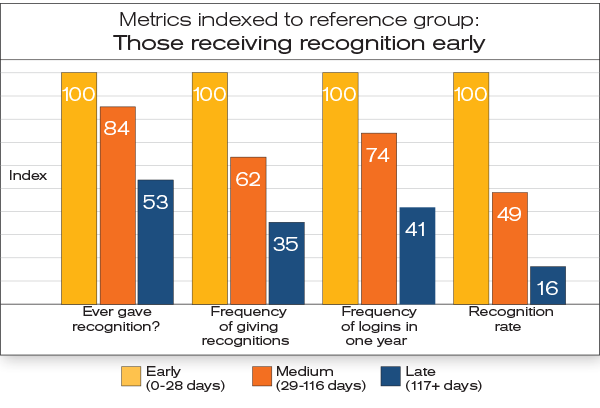An effective employee recognition program relies on active participation from both employees and leaders. But how can a company ensure participation? Recognizing people early in their tenure is a proven strategy to boost employee engagement.
Early recognition can have a major impact on employees. BI WORLDWIDE’s Insights Lab analyzed over 500,000 employees who received at least one recognition across 12 different recognition programs. These employees were divided into three equal-sized groups based on the number of days between their first day of employment and when they received their first recognition.

The goal of this analysis was to compare the behaviour of these groups on key measures of engagement. The measures were indexed to the highest rate group, meaning that engaging at the same rate would have an index of 100, engaging at half the rate would have an index of 50, etc.
One key measure of engagement is the giving and receiving of peer-to-peer recognition. Looking at the percentage of employees who ever gave a recognition to a coworker, the index is much higher in the group that received recognition the earliest in their tenure. Those who didn’t receive recognition within the first four months of employment are half as likely to engage in giving recognition.
An even stronger pattern emerges when looking at the frequency of giving peer-to-peer recognition. The employees in the Early Recognized group give recognition at a higher rate than those in the Late Recognized group.
Employee logins to the program are also a measure of engagement, as it shows that employees are aware of the program. Employees who are engaged in the program will log into the program site, increasing the prominence of the program. Those in the Early Recognized group log in much more often during their first year of employment.
Lastly, effective recognition also inspires more of the same behaviours that are being recognized. The Early Recognized group receives recognition more often throughout their employment.

Research has proven that strategic, best-in-class employee recognition programs can have many benefits, including reduced turnover, improved company culture and increased productivity. These benefits can’t be realized until employees across the organization are engaged in the program.
Recognition early in an employee’s tenure is clear in driving engagement, as those employees are more fully engaged in supporting a recognition-rich culture. They’re more likely to recognize coworkers in general and at a higher rate, and they’re more engaged with the program platform. They also repeat recognized behaviours, so they receive recognition at a higher rate.





